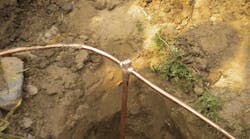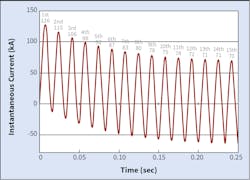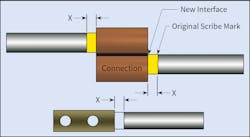When electrical professionals install grounding systems, they need to have confidence that the design and installation will assure protection reliably for the expected life of the system. Grounding connections are the most susceptible link in the grounding system to corrosion because they are buried in the soil.
To confirm the reliability of permanent grounding connections, IEEE 837, Qualifying Permanent Connections Used in Substation Grounding, is the most rigorous and highly regarded grounding connection testing standard in the world. Specifically developed for substation grounding, this standard is considered state of the art for anyone concerned about the safety and reliability of grounding. The Institute of Electrical and Electronics Engineers, Inc. (IEEE) is the world’s largest technical professional organization, boasting nearly 1,300 standards that are either under development or in use.
So how can engineers, owners, and installers ensure permanent grounding connections meet Standard IEEE 837 and will remain dependable throughout the grounding system’s life?
What is in IEEE 837?
Last updated in 2014, IEEE 837 provides direction and methods for qualifying permanent connections used for substation grounding. It’s one of the most difficult standards to pass for grounding connections. In particular, Standard IEEE 837 addresses:
- Connections used within the grid system (Photo 1).
- Connections used to join ground leads to the grid system.
- Connections used to join the ground leads to equipment and structures (Photo 2).
The standard applies to testing connections joining copper, steel, copper-bonded steel, copper-clad steel, galvanized steel, and stainless steel.
The purpose of IEEE 837 is to:
- Assure users that connections will perform reliably over the lifetime of the installation.
- Test the connections for heat and mechanical forces using an electromagnetic force test.
- Satisfy connection criteria outlined in IEEE Standard 80, Guide for Safety in AC Substation Grounding.
This standard defines a repeatable test program that enables connection manufacturers to qualify their products as permanent grounding connections. Upon passing the test, users can be confident that the qualified permanent grounding connection is capable of performing reliably over the lifetime of the installation.
IEEE 837 test overview
The tests are intended to ensure the reliability of grounding connections to withstand mechanical stress and heat during the electromagnetic force (EMF) test and accelerated corrosion or sequential test. What must be tested?
- Each style or family of connection. For example, crimped lug connections and lugs using bolted pressure plates to secure the cable are considered different styles. Therefore, both connectors are required to be tested to qualify the styles.
- A connector’s broadest combination range. When a connector design allows for a range of conductors, each of the tests must be performed on the “largest to largest” combination as well as the “largest to smallest” combination.
- Individually and sequentially. Each style, combination, and sample must be tested separately to ensure a fair and uninfluenced test.
- Connectors with all relevant materials. For example, if a connector can be used on copper and copper-bonded steel, then it must be tested with both conductor types.
Each of these requirements makes the test more rigorous ― and thus more reliable ― in its field applications.
Types of tests
Two categories of tests must be performed to assess the connection: mechanical tests and sequential tests.
Mechanical tests ― The mechanical test, or EMF test, is conducted to determine if electromagnetic forces would damage the connection during a fault. During the test (Fig.1), four samples (each tested separately) are subjected to 15 cycles of a severe current twice.
The pass/fail criterion is based on the movement of the conductor. The connector must not fail (i.e., overheat, or allow cable slippage) and shall not exceed either 10 mm of slippage or the outer diameter of the conductor, whichever is less. The edge of the connection is marked before testing (Fig. 2), then measured to the connector following the tests.
Sequential tests ― These tests, performed in sequence on the same samples, monitor accelerated corrosion, the connection’s reliability, and performance. There are four sequential tests as part of IEEE 837.
- Current-temperature cycling. When fluctuating currents cause temperature changes, does the connection continue to conform to resistance criteria?
- Freeze-thaw test. When subjected to repeated cycles of freezing and thawing in water, is connection resistance maintained?
- Corrosion tests. Two tests are designed to evaluate the corrosion resistance of the connections.
- Salt spray (for above-ground applications). Measures the corrosive effect of salt spray (i.e., sodium chloride) on the connections.
- Nitric acid (for direct burial applications). Measures the effects of acid attack, specifically nitric acid (HNO3), on connections.
- Fault-current tests. Test to determine if connections subjected to the previous tests will withstand fault-current surges.
Kristen Semersheim is the global product director for nVent ERICO. The company can be reached at https://www.nvent.com/en-us/products/cadweld/cadweld-contact-us.





